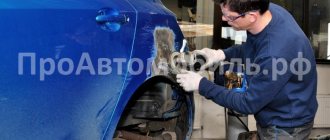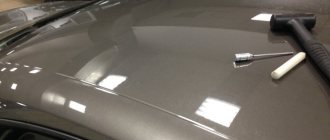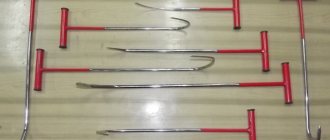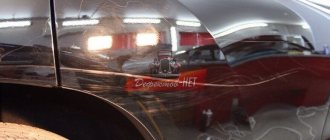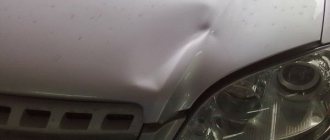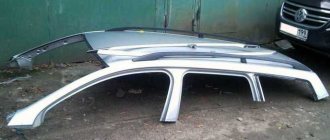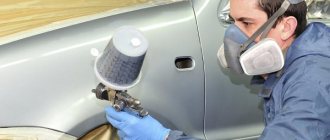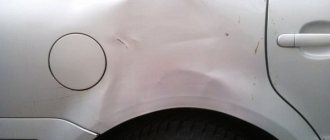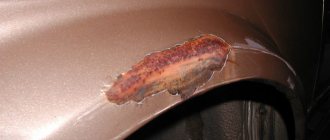Removing dents without painting will quickly return the body surface to its original condition. Naturally, the appearance of dents on the body of a car causes unpleasant emotions for its owner. And no matter how hard you try to take care of your beloved car, no one is immune from troubles, even the most careful driver.
The technology for removing dents without painting has become widespread today. Day by day, motorists' interest in this revolutionary process of restoring body parts is growing.
What dents can be removed without painting the car?
Of course, not all body damage can be eliminated without major repairs. Today, advanced technology for removing dents without painting copes with the consequences by 97-100%:
- bottles, apples, icicles, hail, snowballs falling on the car;
- unscheduled parking;
- careless opening of doors;
- external pressure of hands and feet on the body element.
Modern equipment and the skill of a bodyworker can easily remove a dent of any size. It is important that the paintwork is not damaged and the degree of metal stretching is small (read about the main types of body repairs). Only a qualified specialist can accurately determine the possibility of paintless dent removal. He will also tell you the exact price for the upcoming repairs.
How to pull out a dent on a car with your own hands
You can begin to independently remove dents from the car body, without painting it, if the following conditions exist:
- the deformation on the body has a smooth shape, without kinks,
- The body paintwork is not damaged,
- the dent on the body was not painted,
- The car has not been in use for a relatively long time, and traces of corrosion and cracks have not yet appeared on its paintwork.
In all other cases, if the paintwork has even slight signs of wear, special equipment and high qualifications are required. Watch the video about removing dents from the body below
There are only three ways to remove a dent from the surface of the body with your own hands: 1) using a vacuum, 2) using glue, 3) using PDR technology.
How to pull out a dent with glue
First you need to get a Pops-a-Dent repair kit or a glue gun.
Dent Removal PROCESS Using Pops-a-Dent Kit
- Degrease the entire area of the dent and wipe with a dry cloth; the surface should remain perfectly clean, free of dust and lint.
- Melt the glue, apply it to the nozzle from the kit and, using movements simulating screwing - first to the right, then to the left, press it against the dent. IMPORTANT! The glue should come through the holes of the nozzle - this way the nozzle will attach more firmly.
- After 3 minutes, when the glue has cooled, put the wing attachments on the threads and you can begin to pull out the dent to the level of the adjacent surfaces of the body. This must be done carefully, without sudden movements.
- When you manage to straighten the dent, you need to leave it, along with the attached structure, for about 7 minutes.
- Remove the wing and the arc, after which only the attached nozzle will remain on the body.
- Lightly heat the nozzle with a hair dryer.
- Using the same movements as they attached it to the body, only now unscrewing it - to the right and left - disconnect the nozzle.
Video: Removing a Dent Using the Pops-a-Dent Kit
If you use a glue gun to remove a dent, you will also need an arc and a nozzle. The role of the nozzle will be a bolt with a wide head.
PROCESS for removing dents with a glue gun
- Apply melted glue to the dent.
- Press the head of the bolt against it.
- Wait 1-2 minutes for the glue to cool.
- Apply a second layer of melted glue on top of the first layer and the bolt head until both layers stick together.
- Next, put on the arch and start pulling. Further actions are the same as when working with Pops-a-Dent.
How to remove a dent using a vacuum
A vacuum is a more gentle option for body repairs when removing dents without painting, compared to using glue. After all, after disconnecting the nozzle, when the dent has already been straightened, you need to clean the body of any remaining glue, and this can lead to damage to the paintwork. Removing dents with a vacuum is appropriate when the dent is small.
Vacuum suction cups come in different sizes; the best option is when the area of the adhering surface of the suction cup is slightly smaller than the area of the body dent. It turns out that the boundaries of the applied suction cup do not reach the boundaries of the dent a little.
Vacuum dent removal process
- Degrease the work surface.
- Apply a suction cup and use a pump to create a vacuum
- After the suction cup is firmly secured, begin to pull out the deformation area on the body to the desired level.
- Remove the vacuum by opening the valve, after which the suction cup itself will separate from the car body.
Video: Vacuum dent removal
Benefits of removing dents without painting your car
The new method of removing dents without painting has already caught the fancy of many motorists. More and more owners of cars with body damage are using this service for a number of reasons.
- Firstly, body work is completed quickly. With traditional body repair technology, you need to wait several days for your car. This is explained by the fact that each layer of putty, primer and paint applied must completely dry and harden, after which the car is also painted. And this takes a lot of time. Removal of dents using modern technology occurs within 15-90 minutes. During this time, the car owner can drink a cup of coffee or tea, and also make a few important phone calls.
- The second important advantage of painting-free dent removal is the availability of the work. The formation of the cost of work is not influenced by such expensive materials as putty, paint, varnish, etc. Typically, such dent removal costs the owner 2 times less than with traditional methods of body repair.
- Most often, dents can be removed without dismantling body parts and interior trim. But when repairing the roof, as well as in the absence of free space, specialists resort to removing the trim, lights and body elements themselves. But the factory paint retains its protective functions after such restoration.
- Some car repair shops provide an approximate estimate of dent removal based on photographs. To do this, the owner just needs to take a photo of the damaged area of his car and send the image by email. The driver will only have to make an “appointment” and take with him the required amount of money.
Existing methods for removing hail dents
The procedure for removing dents without painting is fundamentally different from body repair with paint restoration. Indeed, in the case of the latter, the car body is subject to partial disassembly, which requires a significant amount of time and effort. The process of removing dents occurs directly on the body without the need to dismantle its individual parts. Currently, experts use four main methods:
- lever;
- adhesive;
- vacuum;
- thermal.
All of them belong to the so-called PDR methods, that is, paintless methods of removing dents (Paintless Dent Removal - English). Let's look at each of them separately:
- The lever method is the most popular at service stations, as it involves the use of special levers. Carrying out repairs can sometimes be difficult because it is not possible to place the levers directly under the affected areas of the machine body. In addition, often in order to get to individual surfaces of the body, it is necessary to dismantle elements of the interior trim or technological mechanisms.
- The adhesive method is carried out using special tools that literally pull the dented surface back. To do this, special pistons are glued to the damaged area, which are subsequently pulled upward, and they, in turn, pull the surface of the body along with them.
- Vacuum method . This method is similar to the glue method. Its only difference is that instead of glued pistons, vacuum suction cups are used.
- The thermal method of removing dents after hail without painting is based on sharp heating of the damaged surface followed by rapid cooling. As a result of this approach, the body is deformed and returns to its original shape. They are usually heated with a hair dryer and cooled with compressed air.
Do not delay repairs after deformation of the surface of the case, since metal tends to remember the new shape. Therefore, the more time passes, the more difficult it will be to correct the situation. In addition, if deformed, there is a risk of damage to the paintwork. If it is not restored, there is a risk of corrosion.
The history of the emergence of paintless dent removal technology
It is generally accepted that the technology for removing dents without painting a car appeared in Germany in the 1950s at the Mercedes-Benz factories.
The inventor of a new method of dealing with dents, Oscar Flyg, first used it at automobile exhibitions in America and Germany. Overnight, the bodybuilder managed to eliminate all the damage to the exhibition exhibits that appeared due to the negligence of numerous visitors. Later, a special tool for this type of body work was designed and manufactured.
There are several designations for paintless dent removal technology:
- PDR (Paintless Dent Repair) - English designation.
- DOL (Dellen Ohne Lackieren) is a German designation.
Both translate to paintless dent repair.
The magical process came to our country from the USA, where it became widespread and earned the trust and approval of American drivers. However, back in the 80-90s of the last century and at AZLK, some self-taught bodybuilders eliminated dents in a similar way. But, unfortunately, our sluggishness prevents us from implementing emerging innovations in a timely manner. And then we have to learn from our Western colleagues.
How to remove a dent without painting the car
The principle of removing a dent on a car body element is quite clear and simple:
- It is necessary to create pressure on the convex surface with massaging movements from the inside. This is done using special metal rods and hooks. They are equipped with comfortable non-slip handles and a set of tips. In the hands of a professional, such simple tools can work wonders.
- Qualified craftsmen use special lamps to detect dents and visually monitor the progress of straightening. The reflection of the light from the lamps makes it possible to accurately determine the boundaries of the damaged area.
- To pull out a small dent with your own hands, car enthusiasts most often use special kits like Pops-a-Dent and the like. In some cases, they allow you to independently eliminate geometry violations, returning the body to its original appearance ( see the video below for an example ).
- After removing the dents, the body element is polished, if necessary. It is designed to eliminate stains left by the tool and the hands of the master.
Well, now we know that removing dents without painting greatly simplifies car body care. Both bodybuilders and motorists will benefit. The absence of dust and solvent vapors improves the microclimate in the workshop premises, and the driver enjoys quick body repairs and saving a significant amount of money.
Do-it-yourself leveling of dents without painting
Local body repair will no longer require the use of a welding machine to restore the body, carrying out the entire range of preparatory work (cleaning the body surface, puttingtying and polishing it, priming), as well as the final application of paint and varnish.
before starting dent repair
By pulling out dents without painting, body defects can be eliminated, and no visible marks will remain at the site of the restoration work.
It will be problematic for a beginner to carry out such repairs; moreover, it is necessary to have special tools. But you can purchase such a kit at a specialized auto store and learn all the intricacies of pulling out dents.
You can study the theory of repairs using training videos on the Internet, as well as on our website, so that there is no longer any doubt - practice on an unnecessary part of the car body. Repairs should be carried out in stages:
- Before carrying out repairs, the working surface must be cleaned - washed and waited for it to dry.
- In all bending areas, it is necessary to carefully relieve tension. For this, cores and a special hammer are used.
- You can straighten the dent using a vacuum or glue.
- Then you need to straighten the remaining dents. It is better to do this from the inside of the body (if there is access) using special hooks.
If the dent is large enough, a special suction cup is placed on it, and adapters are glued to small defects. You can level the dent manually or use a mini-lifter for this. The metal must be pulled up to a certain level, so the surface of the body is completely restored.
All small irregularities can be removed using a bumper (such devices are made of a special material and have a cigar shape). It is necessary to control the process of leveling the dent visually, so work should be carried out in good lighting.
By the shape of the glare of light reflected from the surface, you can determine the level of distortion of the case and the overall degree of irregularities that need to be corrected.
This is interesting: Why do you need to tow a car?
You can influence the defect from the inside using special mechanical levers, which are equipped with a handle for more convenient use. If there is no access to the damaged area, it makes sense to dismantle part of the body to carry out all the necessary work.
After all restoration work to remove dents from the car body has been completed, the treated area can be further polished.
Video: removing dents without painting with the Pops-a-Dent set
Dents on a car are probably known to every motorist. It would seem that there is nothing serious here, because you can simply take the car to a service station and entrust everything to the specialists. But you should also take into account the fact that you will have to leave the car for several days and pay a lot of money. Therefore, it makes sense to learn how to eliminate such defects yourself.
Removing a dent with your own hands
Types of Dents
First you need to decide on the dent itself. It is customary to distinguish between the following types of damage:
- deep - dents with a depth of 10 mm, sometimes more. As a rule, such damage does not have a clear oval shape. In this case, it is impossible to remove the dent on your own;
- shallow - metal deflection is no more than 5 millimeters, the paintwork is not damaged. Such defects can be eliminated yourself.
It is these dents that we will talk about further. Such damage can be repaired at home.
Body diagnostics
Before you begin the car repair itself, you need to carefully inspect the car body. It is better to do this in good light - this way all the damage will be
Please note that if more than one dent is found on the surface of the car, repair work should begin with the smallest damage, gradually moving to the largest.
Also, before you start pulling, you should make sure that the paintwork is in good condition. If the paint is badly damaged, straightening without painting will not be possible. In this case, the defect will have to be removed using the traditional method of straightening the car.
Removing dents without painting
Let's sum it up
As you can see, there are quite a few different ways to repair dents on a car body. At the same time, knowing how to pull out a dent without painting, in some cases, allows you to quickly and effectively remove damage of this type with your own hands.
We also recommend reading the article on how to remove rust from a car body with your own hands. From this article you will learn about the available methods for removing rust on a body, as well as what subtleties and nuances you should pay attention to as part of this procedure.
For simple cases, the methods discussed above make it possible to perform body repairs with sufficient quality at minimal cost. At the same time, to repair complex damage, it is optimal to have a set of professional tools for repairing dents without painting.
However, it is important to understand that a lot also depends on the experience and skills of the specialist performing the repair itself. For this reason, if the damage is complex (for example, the metal is jammed or severely deformed), it is better to immediately contact specialized body repair centers.
If the dent has smooth edges or the damage is minor, the use of the methods discussed above for removing dents without painting can quite effectively eliminate defects on the body.
Straightening methods
There are several ways to remove mechanical damage to a car body:
- through a set of levers;
- magnet;
- applicators;
- heating followed by cooling.
Each of these methods has both its advantages and disadvantages.
Please note that it is impossible to perform such work yourself if:
- the scale of deformation is large;
- the car is very old;
- the damage is in the threshold area;
- The LKS was severely damaged.
In such cases, you should contact competent specialists.
DIY bumper repair
Lever method
The method of straightening the surface of a car without painting using levers is used more often. But it should be noted that this process is much more complicated. Therefore, before straightening your car, it is better to practice on other surfaces.
First you need to purchase a set of special levers. On average there are about 40 pieces. It looks something like this:
Levers for straightening cars
To begin repairs, you need to provide free access to the damage site. To do this, all third-party elements (trimming, mirrors, headlights, handles) must be carefully removed.
Dent removal is carried out only from the inside of the vehicle. To do this, you need to select a hook of the optimal length and gently press on the indentation, gradually leveling the metal.
This technology without painting can be used even if classical straightening has already been used previously. The use of the hook method is contraindicated if the surface of the car has previously been puttied. In this case, this layer will simply fall off.
Paintless DIY methods for removing dents
In each of the methods described below, different approaches to repairing a car body with your own hands will be considered, so the costs for them will be slightly different. You can pull out a dent either with the help of a tool that is unlikely to be lying around in your garage, or with the help of very ordinary devices.
- "Applicator" as a means of pulling out dents
This technology is suitable if you can work with the dent from the outside of the body.
"Applicator" for removing dents
To begin work, the surface of the damage must be thoroughly washed and then degreased. Next, you need to determine the approximate center of the dent. This is necessary for applying applicators to it. “Applicators” are glued using a special thermal glue, which tends to harden very quickly. Wait a couple of minutes until the composition hardens well, and then you can use a bracket with a screw screwed into the center, or a mini-lifter known to many. Despite the fact that the glue leaves absolutely no marks on the paintwork, you can overdo it and pull out the dent too much. That is why it is worth approaching this procedure with full responsibility.
- PDR lever technology for manual dent removal
This method will require a special tool. This is a set of levers of different shapes and lengths, the ends of which are bent using a special technology. But don’t despair, because you can buy it at any car store or even at the market.
Work should begin from the inside of the dent. To straighten the defect, you need to select a lever of the required length and gently press it on the bulge. Thanks to such simple manipulations, the metal will return to its place.
Lever technology PDR
The technology, called PDR, is also perfect for surfaces that were previously painted or straightened. It allows you to reduce the flaw with your own hands to an almost imperceptible level. The only thing that can hinder the use of this method is the presence of putty on the working surface, which in its dry form is unfriendly to changing shape.
The inconvenience of this method is that it may require dismantling some body elements. However, if you have good access to the dent on both sides, this procedure can be avoided.
- Removing dents on the body using a heating-cooling procedure
Similar to the method for pulling out dents, in this method the work will be carried out on the outside of the dent. To remove a dent with your own hands by heating and cooling, you will need a cylinder filled with compressed air and a powerful hair dryer. This method is very dangerous, because the work takes place in a rather extreme temperature environment. The temperature of the air leaving the cylinder is minus 78 degrees Celsius, while a hair dryer can heat the surrounding air up to 600 degrees. That is why it is better to work in a protective mask (or glasses) and durable gloves.
This is interesting: Do-it-yourself spray painting of a car
Repairing a dent
The procedure for eliminating a defect on a car begins with heating the dent. Using smooth movements with a hairdryer, the dent is heated along the radius. After which the defect site is immediately treated with cold air supplied from a cylinder. Due to a sharp temperature change, the bulge is leveled out, and the paintwork remains intact.
If you use any of these methods, don't forget to use a polish so your car will shine like new again.
Leveling with applicator
The applicator method is used if straightening from the inside is impossible.
Before starting repairs, the surface of the machine must be thoroughly degreased. Next, round or square applicators are attached to the surface with glue (along the edges of the dent). The central part of the damage is leveled using a mini-lifter or a staple with a central screw. This must be done very carefully, as you can easily “pull” the dent.
It should be noted that this pulling method does not require large material costs or special skills. It's not difficult to do this yourself.
Heating-cooling
For this method of editing at home without painting, you need to have:
- construction hair dryer;
- compressed air;
- personal protective equipment (gloves, respirator);
- polish.
The essence of such repair of the vehicle surface without painting is that due to the temperature difference, the metal straightens. Editing is carried out according to the following algorithm:
- the dent is heated by smooth movements along the radius;
- The dent is cooled using compressed air.
If the damage is medium in size, heating should be carried out in several places. At the end of the process, the treated area must be treated with polish. Fixing a dent yourself in this way is very simple and inexpensive.
Types of dents
First of all, you need to deal with the defect itself. The following varieties are distinguished:
- Deep. The depth of the defect is up to 10 mm, but it can be greater. In this case, the damage, as a rule, will not have an oval shape. It will be difficult to remove the dent yourself. It's better to turn to the experts.
- Shallow. The depth of these dents is no more than 5 mm. If the paintwork is not damaged, then with diligence it is possible to remove the defect yourself.
Below in the article we will look at how to remove shallow damage on car doors, fenders, hood or on the roof and other elements of the car body.
Rules for straightening a dent
- A body panel stamped from sheet metal acquires so-called “memory”. That is, if a change in the shape of the panel occurs, then this state is unnatural for it; the metal is in a stressed state and strives to take its natural shape. Your job is to relieve this tension.
- You should try to pull out the dent as quickly as possible after it forms. After a long time, the deformed metal, as it were, acquires a new “memory”, like stamped metal, the ductility of the metal decreases. If you do not pull out a dent for a long time, then there is a high probability that a trace of the dent will remain after it is pulled out.
- When a dent forms on the body, the metal not only deepens, the edges around the dent also rise above the general contour of the surface. The more convex the body panel, the more pronounced this is. It turns out something like a small volcano. For this reason, when straightening some dents, you need to tap the raised areas around them (sometimes not noticeable). For smooth dents that do not have wrinkles or damaged paint, light tapping by hand can be done in addition to the other pulling methods discussed in this article.
A dent on a convex or slightly convex surface may have raised areas along its edge.
- When the metal is heated, it is easier to straighten it. In professional body repair and PDR technology, adequate heating of the metal is used to straighten dents. This increases the elasticity of the metal and significantly reduces dent stress. Heating works better on larger dents. A hairdryer is used for heating. A regular hair dryer may not be enough, but it can also make the dent easier to pull out. When using a hair dryer, you should not stop in one place for a long time, as you can damage the paint. You need to use it at medium settings and constantly move it, at a distance of about 10 cm from the surface.
We recommend: How to choose tires for a car?
